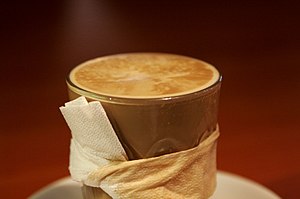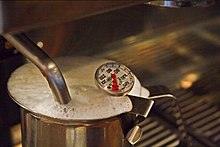Latte: Difference between revisions
No edit summary |
Cosmic Latte (talk | contribs) Undid revision 326787215 by 83.233.158.156 (talk) apparently, "caffellate" is the correct Italian spelling |
||
| Line 3: | Line 3: | ||
[[Image:Latte.jpg|thumb|300px|A latte wearing a napkin scarf.]] |
[[Image:Latte.jpg|thumb|300px|A latte wearing a napkin scarf.]] |
||
A '''latte''' (from the Italian ''''' |
A '''latte''' (from the Italian '''''caffellatte''''', meaning "coffee [and] milk") is a type of [[coffee (drink)|coffee]] drink made with hot [[milk]]. Variants include replacing the coffee with another drink base such as [[chai]], [[Mate (beverage)|mate]] or [[matcha]]. The word is also sometimes spelled '''latté''' or '''lattè'''—the incorrect [[Diacritic|diacritical mark]] being added as a [[hypercorrection]], as fit for many French words with a pronounced final ''e'', but unnecessary in Italian words, where all vowels are always pronounced. |
||
==Origin== |
==Origin== |
||
Revision as of 16:38, 21 November 2009
This article needs additional citations for verification. (December 2007) |

A latte (from the Italian caffellatte, meaning "coffee [and] milk") is a type of coffee drink made with hot milk. Variants include replacing the coffee with another drink base such as chai, mate or matcha. The word is also sometimes spelled latté or lattè—the incorrect diacritical mark being added as a hypercorrection, as fit for many French words with a pronounced final e, but unnecessary in Italian words, where all vowels are always pronounced.
Origin
In Italian latte (Italian pronunciation: [ˈlatte], English: /ˈlɑːteɪ/) means milk. What in English-speaking countries is now called a latte is shorthand for "caffelatte" or "caffellatte" ("caffè e latte").[1][2][3][4] The Italian form means "coffee and milk", similar to the French café au lait, the Spanish café con leche and the Portuguese café com leite. Caffe latte is today part of the defined international coffee menu, which also includes cappuccino and espresso.
Ordering a "latte" (a term used in many English-speaking countries for a coffee with milk) in Italy will get a glass of hot or cold milk[5].
According to the Oxford English Dictionary the term caffè latte was first used in English in 1847 (as caffe latto), and in 1867 as caffè latte by William Dean Howells in his essay "Italian Journeys".[6] However, in Kenneth Davids' Coffee: A Guide to Buying, Brewing and Enjoying it is said that "At least until recently, ordering a "latte" in Italy got you a puzzled look and a hot glass of milk. The American-style caffe latte did not exist in Italian caffes, except perhaps in a few places dominated by American tourists... Obviously breakfast drinks of this kind have existed in Europe for generations, but the caffe version of this drink is an American invention..." [7]
Caffe Mediterraneum, a landmark cafè in Berkeley, California, claims to be the birthplace of the cafè latte, crediting its birth to one of the cafè's owners, Lino Meiorin. According to a sign that is proudly displayed in the cafè, Lino was the first Italian-trained barista in the San Francisco Bay Area, and his Italian-style cappuccinos were apparently too strong for the customers. In response to his customers, he decided to add a larger, milkier cappuccino to the menu, and he called this drink the "caffe latte".[8]
Current use

In Italy, caffè latte is almost always prepared at home, for breakfast only. The coffee is brewed with a stovetop Moka and poured into a cup containing heated milk. (The Moka does not produce true espresso, but rather a double-strength coffee. Also, unlike the international latte drink, the milk in the Italian original is not foamed.)
Outside Italy, a caffè latte is typically prepared with approximately 1/3 espresso and 2/3 steamed milk, with a layer of foamed milk approximately 5 mm (¼ inch) thick on the top. A caffè latte may also be served consisting of strong or bold coffee (sometimes espresso) mixed with scalded milk in approximately a 1:1 ratio.[9] The drink is similar to a cappuccino, the difference being that a cappuccino consists of espresso and steamed milk with a 2 cm (¾ inch) layer of thick milk foam. A variant on the latte is the flat white, which is served in a smaller ceramic cup with the creamy steamed milk poured over a single-shot of espresso, holding back the lighter froth at the top.
Serving styles
- In some establishments, lattes are served in a glass on a saucer with a napkin which can be used to hold the (sometimes hot) glass.
- A latte is sometimes served in a bowl.
- The relatively high prices demanded by some establishments have led to the creation of ghetto latte or bootleg lattes, whereby customers mix their own latte by ordering a lower-priced cup of espresso and then mixing it with milk and other condiments offered for free at the condiments bar.[10]
- In Asia and North America, lattes have been combined with Asian teas. Coffee and tea shops now offer hot or iced latte versions of chai, matcha, and Royal milk tea.
- Other flavorings can be added to the latte to suit the taste of the drinker. Vanilla, chocolate, and caramel are all popular variants.
- In South Africa a red latte is made with rooibos tea.
See also
References
- ^ As a single word, the phrase skips the conjunction "e" and gets the double "l" because of syntactic doubling http://oxfordparavia.it/lemmaIta4544 http://www.demauroparavia.it/17050
- ^ It is a type of English to shorten long names, whether foreign or not, cf. telex > teleprinter exchange, fax > facsimile printer, pop or soda > soda pop, OJ > orange juice, etc. (all http://www.merriam-webster.com/dictionary)
- ^ latte - Definition from the Merriam-Webster Online Dictionary
- ^ latte - Definitions from Dictionary.com
- ^ http://www.msadventuresinitaly.com/blog/2007/07/11/how-to-order-an-italian-coffee-in-italy/ Coffee traditions in Italy
- ^ http://dictionary.oed.com/cgi/entry/00333261?query_type=word&queryword=latte&first=1&max_to_show=10&single=1&sort_type=alpha
- ^ http://books.google.com/books?id=IqJsIcYOPcQC&pg=PA153&lpg=PA153&dq=caffee+latte+berkeley+invented&source=web&ots=EBJjREHjF6&sig=2WhpL_g7xwYEtawGsmp0WDtJXkw&hl=en&sa=X&oi=book_result&resnum=2&ct=result#PPA153,M1
- ^ http://www.caffemed.com/about_us
- ^ http://www.decs.nl/nl/OutOfHome/OverKoffie/KoffievariatiesVanDeWereld/ "Coffee Variations Dicionary" (Dutch) composed by the Dutch coffee branche Douwe Egberts
- ^ Leroux, Charles (5 October 2006). "The bootleg latte: Would you make one?". Chicago Tribune. Retrieved 2008-07-18.
